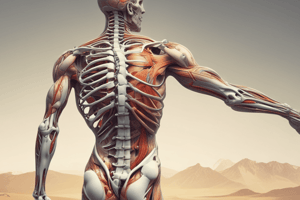Podcast
Questions and Answers
In a seated position during iliopsoas manual muscle testing, what two positions must the hip and knee be in?
In a seated position during iliopsoas manual muscle testing, what two positions must the hip and knee be in?
The hip must be flexed fully, and the knee must be flexed.
What is the purpose of applying counterpressure to the patient's ipsilateral anterior shoulder during the iliopsoas MMT?
What is the purpose of applying counterpressure to the patient's ipsilateral anterior shoulder during the iliopsoas MMT?
Counterpressure is applied to stabilize the patient and enhance the accuracy of the resistance being measured.
How should the clinician position their hands during the hip extension resistance application in the iliopsoas MMT?
How should the clinician position their hands during the hip extension resistance application in the iliopsoas MMT?
One hand should be on the patient's ipsilateral anterior shoulder for counterpressure, while the other is placed proximal to the knee.
Why is it important for the hip to be in a fully flexed position when conducting the iliopsoas MMT?
Why is it important for the hip to be in a fully flexed position when conducting the iliopsoas MMT?
What muscle group is primarily being assessed during the iliopsoas manual muscle testing when the hip is flexed and the knee is flexed?
What muscle group is primarily being assessed during the iliopsoas manual muscle testing when the hip is flexed and the knee is flexed?
Flashcards
Iliopsoas MMT Position
Iliopsoas MMT Position
Patient seated, hip fully flexed, and knee flexed.
Resistance Direction (MMT)
Resistance Direction (MMT)
Resisting hip extension.
Counterpressure Location (MMT)
Counterpressure Location (MMT)
On the patient's shoulder, ipsilateral to the tested leg.
Knee Hand Location (MMT)
Knee Hand Location (MMT)
Signup and view all the flashcards
MMT Hand Position
MMT Hand Position
Signup and view all the flashcards
Study Notes
Iliopsoas Muscle Manual Muscle Testing (MMT)
- Patient Positioning: Seated
- Hip: Fully flexed
- Knee: Flexed
- Resistance: Applied to hip extension
- Testing Hand Placement: One hand on patient's ipsilateral anterior shoulder for counterpressure, the other hand proximal to the knee.
Studying That Suits You
Use AI to generate personalized quizzes and flashcards to suit your learning preferences.




